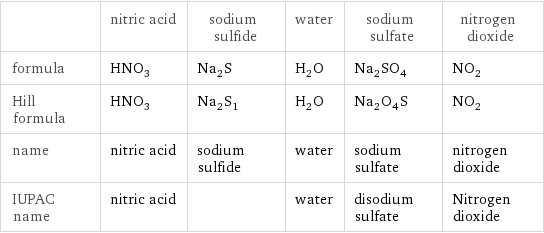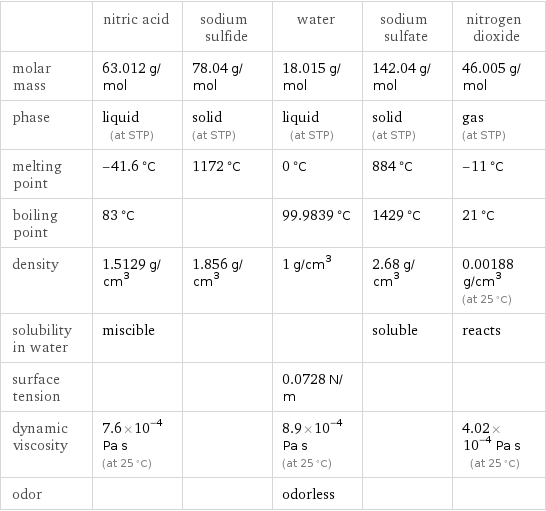Input interpretation

HNO_3 nitric acid + Na_2S sodium sulfide ⟶ H_2O water + Na_2SO_4 sodium sulfate + NO_2 nitrogen dioxide
Balanced equation

Balance the chemical equation algebraically: HNO_3 + Na_2S ⟶ H_2O + Na_2SO_4 + NO_2 Add stoichiometric coefficients, c_i, to the reactants and products: c_1 HNO_3 + c_2 Na_2S ⟶ c_3 H_2O + c_4 Na_2SO_4 + c_5 NO_2 Set the number of atoms in the reactants equal to the number of atoms in the products for H, N, O, Na and S: H: | c_1 = 2 c_3 N: | c_1 = c_5 O: | 3 c_1 = c_3 + 4 c_4 + 2 c_5 Na: | 2 c_2 = 2 c_4 S: | c_2 = c_4 Since the coefficients are relative quantities and underdetermined, choose a coefficient to set arbitrarily. To keep the coefficients small, the arbitrary value is ordinarily one. For instance, set c_2 = 1 and solve the system of equations for the remaining coefficients: c_1 = 8 c_2 = 1 c_3 = 4 c_4 = 1 c_5 = 8 Substitute the coefficients into the chemical reaction to obtain the balanced equation: Answer: | | 8 HNO_3 + Na_2S ⟶ 4 H_2O + Na_2SO_4 + 8 NO_2
Structures

+ ⟶ + +
Names

nitric acid + sodium sulfide ⟶ water + sodium sulfate + nitrogen dioxide
Reaction thermodynamics
Gibbs free energy

| nitric acid | sodium sulfide | water | sodium sulfate | nitrogen dioxide molecular free energy | -80.7 kJ/mol | -349.8 kJ/mol | -237.1 kJ/mol | -1270 kJ/mol | 51.3 kJ/mol total free energy | -645.6 kJ/mol | -349.8 kJ/mol | -948.4 kJ/mol | -1270 kJ/mol | 410.4 kJ/mol | G_initial = -995.4 kJ/mol | | G_final = -1808 kJ/mol | | ΔG_rxn^0 | -1808 kJ/mol - -995.4 kJ/mol = -812.8 kJ/mol (exergonic) | | | |
Equilibrium constant
![Construct the equilibrium constant, K, expression for: HNO_3 + Na_2S ⟶ H_2O + Na_2SO_4 + NO_2 Plan: • Balance the chemical equation. • Determine the stoichiometric numbers. • Assemble the activity expression for each chemical species. • Use the activity expressions to build the equilibrium constant expression. Write the balanced chemical equation: 8 HNO_3 + Na_2S ⟶ 4 H_2O + Na_2SO_4 + 8 NO_2 Assign stoichiometric numbers, ν_i, using the stoichiometric coefficients, c_i, from the balanced chemical equation in the following manner: ν_i = -c_i for reactants and ν_i = c_i for products: chemical species | c_i | ν_i HNO_3 | 8 | -8 Na_2S | 1 | -1 H_2O | 4 | 4 Na_2SO_4 | 1 | 1 NO_2 | 8 | 8 Assemble the activity expressions accounting for the state of matter and ν_i: chemical species | c_i | ν_i | activity expression HNO_3 | 8 | -8 | ([HNO3])^(-8) Na_2S | 1 | -1 | ([Na2S])^(-1) H_2O | 4 | 4 | ([H2O])^4 Na_2SO_4 | 1 | 1 | [Na2SO4] NO_2 | 8 | 8 | ([NO2])^8 The equilibrium constant symbol in the concentration basis is: K_c Mulitply the activity expressions to arrive at the K_c expression: Answer: | | K_c = ([HNO3])^(-8) ([Na2S])^(-1) ([H2O])^4 [Na2SO4] ([NO2])^8 = (([H2O])^4 [Na2SO4] ([NO2])^8)/(([HNO3])^8 [Na2S])](../image_source/40a47b6867d89cfc389cee81e1e05a37.png)
Construct the equilibrium constant, K, expression for: HNO_3 + Na_2S ⟶ H_2O + Na_2SO_4 + NO_2 Plan: • Balance the chemical equation. • Determine the stoichiometric numbers. • Assemble the activity expression for each chemical species. • Use the activity expressions to build the equilibrium constant expression. Write the balanced chemical equation: 8 HNO_3 + Na_2S ⟶ 4 H_2O + Na_2SO_4 + 8 NO_2 Assign stoichiometric numbers, ν_i, using the stoichiometric coefficients, c_i, from the balanced chemical equation in the following manner: ν_i = -c_i for reactants and ν_i = c_i for products: chemical species | c_i | ν_i HNO_3 | 8 | -8 Na_2S | 1 | -1 H_2O | 4 | 4 Na_2SO_4 | 1 | 1 NO_2 | 8 | 8 Assemble the activity expressions accounting for the state of matter and ν_i: chemical species | c_i | ν_i | activity expression HNO_3 | 8 | -8 | ([HNO3])^(-8) Na_2S | 1 | -1 | ([Na2S])^(-1) H_2O | 4 | 4 | ([H2O])^4 Na_2SO_4 | 1 | 1 | [Na2SO4] NO_2 | 8 | 8 | ([NO2])^8 The equilibrium constant symbol in the concentration basis is: K_c Mulitply the activity expressions to arrive at the K_c expression: Answer: | | K_c = ([HNO3])^(-8) ([Na2S])^(-1) ([H2O])^4 [Na2SO4] ([NO2])^8 = (([H2O])^4 [Na2SO4] ([NO2])^8)/(([HNO3])^8 [Na2S])
Rate of reaction
![Construct the rate of reaction expression for: HNO_3 + Na_2S ⟶ H_2O + Na_2SO_4 + NO_2 Plan: • Balance the chemical equation. • Determine the stoichiometric numbers. • Assemble the rate term for each chemical species. • Write the rate of reaction expression. Write the balanced chemical equation: 8 HNO_3 + Na_2S ⟶ 4 H_2O + Na_2SO_4 + 8 NO_2 Assign stoichiometric numbers, ν_i, using the stoichiometric coefficients, c_i, from the balanced chemical equation in the following manner: ν_i = -c_i for reactants and ν_i = c_i for products: chemical species | c_i | ν_i HNO_3 | 8 | -8 Na_2S | 1 | -1 H_2O | 4 | 4 Na_2SO_4 | 1 | 1 NO_2 | 8 | 8 The rate term for each chemical species, B_i, is 1/ν_i(Δ[B_i])/(Δt) where [B_i] is the amount concentration and t is time: chemical species | c_i | ν_i | rate term HNO_3 | 8 | -8 | -1/8 (Δ[HNO3])/(Δt) Na_2S | 1 | -1 | -(Δ[Na2S])/(Δt) H_2O | 4 | 4 | 1/4 (Δ[H2O])/(Δt) Na_2SO_4 | 1 | 1 | (Δ[Na2SO4])/(Δt) NO_2 | 8 | 8 | 1/8 (Δ[NO2])/(Δt) (for infinitesimal rate of change, replace Δ with d) Set the rate terms equal to each other to arrive at the rate expression: Answer: | | rate = -1/8 (Δ[HNO3])/(Δt) = -(Δ[Na2S])/(Δt) = 1/4 (Δ[H2O])/(Δt) = (Δ[Na2SO4])/(Δt) = 1/8 (Δ[NO2])/(Δt) (assuming constant volume and no accumulation of intermediates or side products)](../image_source/56c875595afbfad9cbbe1d5acf720e59.png)
Construct the rate of reaction expression for: HNO_3 + Na_2S ⟶ H_2O + Na_2SO_4 + NO_2 Plan: • Balance the chemical equation. • Determine the stoichiometric numbers. • Assemble the rate term for each chemical species. • Write the rate of reaction expression. Write the balanced chemical equation: 8 HNO_3 + Na_2S ⟶ 4 H_2O + Na_2SO_4 + 8 NO_2 Assign stoichiometric numbers, ν_i, using the stoichiometric coefficients, c_i, from the balanced chemical equation in the following manner: ν_i = -c_i for reactants and ν_i = c_i for products: chemical species | c_i | ν_i HNO_3 | 8 | -8 Na_2S | 1 | -1 H_2O | 4 | 4 Na_2SO_4 | 1 | 1 NO_2 | 8 | 8 The rate term for each chemical species, B_i, is 1/ν_i(Δ[B_i])/(Δt) where [B_i] is the amount concentration and t is time: chemical species | c_i | ν_i | rate term HNO_3 | 8 | -8 | -1/8 (Δ[HNO3])/(Δt) Na_2S | 1 | -1 | -(Δ[Na2S])/(Δt) H_2O | 4 | 4 | 1/4 (Δ[H2O])/(Δt) Na_2SO_4 | 1 | 1 | (Δ[Na2SO4])/(Δt) NO_2 | 8 | 8 | 1/8 (Δ[NO2])/(Δt) (for infinitesimal rate of change, replace Δ with d) Set the rate terms equal to each other to arrive at the rate expression: Answer: | | rate = -1/8 (Δ[HNO3])/(Δt) = -(Δ[Na2S])/(Δt) = 1/4 (Δ[H2O])/(Δt) = (Δ[Na2SO4])/(Δt) = 1/8 (Δ[NO2])/(Δt) (assuming constant volume and no accumulation of intermediates or side products)
Chemical names and formulas

| nitric acid | sodium sulfide | water | sodium sulfate | nitrogen dioxide formula | HNO_3 | Na_2S | H_2O | Na_2SO_4 | NO_2 Hill formula | HNO_3 | Na_2S_1 | H_2O | Na_2O_4S | NO_2 name | nitric acid | sodium sulfide | water | sodium sulfate | nitrogen dioxide IUPAC name | nitric acid | | water | disodium sulfate | Nitrogen dioxide
Substance properties

| nitric acid | sodium sulfide | water | sodium sulfate | nitrogen dioxide molar mass | 63.012 g/mol | 78.04 g/mol | 18.015 g/mol | 142.04 g/mol | 46.005 g/mol phase | liquid (at STP) | solid (at STP) | liquid (at STP) | solid (at STP) | gas (at STP) melting point | -41.6 °C | 1172 °C | 0 °C | 884 °C | -11 °C boiling point | 83 °C | | 99.9839 °C | 1429 °C | 21 °C density | 1.5129 g/cm^3 | 1.856 g/cm^3 | 1 g/cm^3 | 2.68 g/cm^3 | 0.00188 g/cm^3 (at 25 °C) solubility in water | miscible | | | soluble | reacts surface tension | | | 0.0728 N/m | | dynamic viscosity | 7.6×10^-4 Pa s (at 25 °C) | | 8.9×10^-4 Pa s (at 25 °C) | | 4.02×10^-4 Pa s (at 25 °C) odor | | | odorless | |
Units
